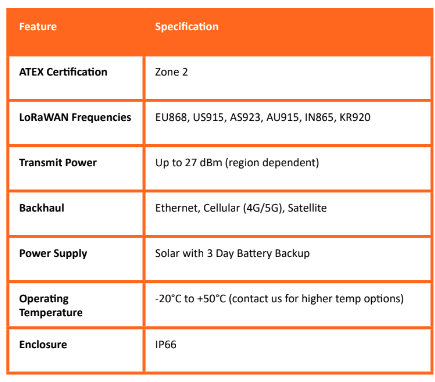

Model: MF Gateway
Model description: MinFarm LoRa EU868 Network Gateway with Solar and Battery Backup Hardware with ATEX zone 2 rating for use with IDP Satellite Terminal with C1D2 Zone 2 rating.
MinFarm LoRaWAN™ Satellite Gateway Overview (MF Gateway)
The MinFarm LoRaWAN™ Satellite Gateway model MF Gateway provides LoRaWAN® sensor connectivity in remote locations where data or power are not available. A LoRaWAN® ‘hotspot’ with a 5 km radius from the MinFarm LoRaWAN™ Satellite Gateway provides a low power wide area network to field LoRaWAN™ Pressure Sensor devices. The MinFarm LoRaWAN™ Satellite Gateway transmits gathered field sensor data uplinks to a customer shore dashboard via its L-band satellite data connection suitable for maritime platforms. This satellite data connection supports command downlinks and has 24/7 global availability. The MinFarm LoRaWAN™ Satellite Gateway’s satellite data usage is predictable and reliable using MinFarm’s protocol optimization and compression. The MinFarm LoRaWAN™ Satellite Gateway is suitable to be deployed in hazordous environments.

Technical Specifications
• ATEX Certified: Compliant with ATEX directives for
safe operation in explosive atmospheres (Zone 1 &
Zone 2).
• LoRaWAN Compliant: Supports all LoRaWAN
regional parameters, ensuring interoperability with a
wide range of sensors.
• Autonomous Solar Power: Solar powered with 3
day battery back up for completely autonomous and
reliable long term use in off grid installations
• High Reliability: Built for industrial environments
with durable components and rugged housing.
• Secure Data Transmission: Employs end-to-end
encryption for secure data transfer from sensor to
cloud.
• Satellite Backhaul Option: Supports various
backhaul methods including Ethernet, Cellular
(4G/5G), and Satellite for flexible deployment.
• Remote Management: Enables remote monitoring
and configuration for efficient operation and
maintenance.
Collapsible content
L-band Satellite Service Overview
The L-band frequency used over a geostationary satellite has a number of attractive features compared to higher powered VSAT or lower power VHF/UHF frequencies. These include:
- Low Power: Smaller terminals can listen for downlinks at power usage levels of 500 mW compared to a VSAT usage of 50 W plus
- Weather Resistant: Unlike most other frequencies, L-band works well in the rain and fog
- Robust Terminals: L-band terminals can use omnidirectional antennas, operate in hazardous areas, and have wide operational temperature ranges
- Reliable Data Connectivity: L-band is well suited to data transfer with latencies and bandwidth throughputs within the range of many use cases for remote asset monitoring when used with the MinFarm optimized satellite protocol architecture
The MinFarm Optimized Satellite Protocol Architecture
The MinFarm Protocol is an optimized protocol for reliable and low-cost data transfer over small L-band satellite terminals. L-band satellite terminals offer many advantages over larger VSAT terminals, however they can present unusual interfaces (Non-IP packet data etc.), higher latencies, and lower bandwidth. To get the best of both worlds (small satellite hardware and fast data transfer), MinFarm has, in cooperation with the European Space Agency, developed a unique software protocol and architecture to overcome the data transfer limitations of small L-band terminals while transmitting data from remote field devices.
IsatData Pro (IDP)
IsatData Pro (IDP):
The IsatData Pro (IDP) is a small (200g) and low power omnidirectional satellite terminal that provides an extremely reliable but low data rate connection in the field. When combined with MinFarm products utilizing the MinFarm optimized satellite protocol and architecture, the IDP terminal is suitable for deployments of less than 100 sensors that transmit once per hour or a small number of remote image capture devices, transmitting infrequently or on demand. The main advantages to using the IDP service over higher power L-band systems such as BGAN (see more below) are its low power usage and relatively low cost, ease of installation, and very robust environmentals. Over 300,000 IDP terminals are in use around the world today.
BGAN
BGAN:
The BGAN is an established medium speed (400 kbps upload and download) satellite terminal used by governments and industry all around the world for satellite data communications in remote locations. With excellent sleep power saving and low power receive mode, the BGAN can operate in a suitable manner to fit autonomous operation from solar panels for year round installations. The BGAN uses a small directional antenna that is relatively simple to install and use. MinFarm products use the BGAN for providing reachback connectivity to larger deployments, as it supports up to 4000 sensors.